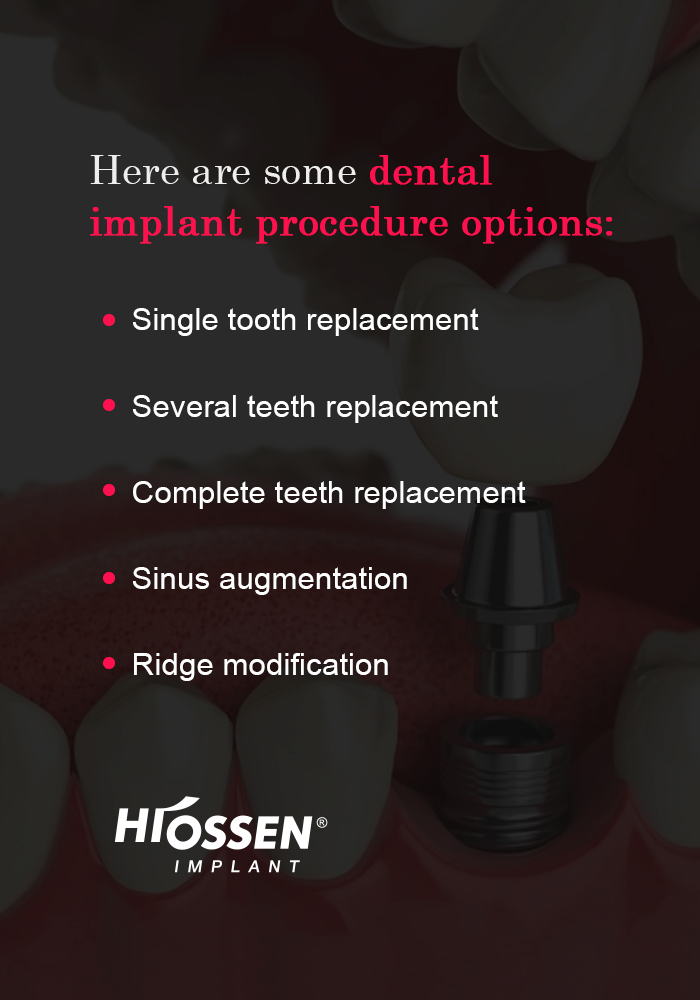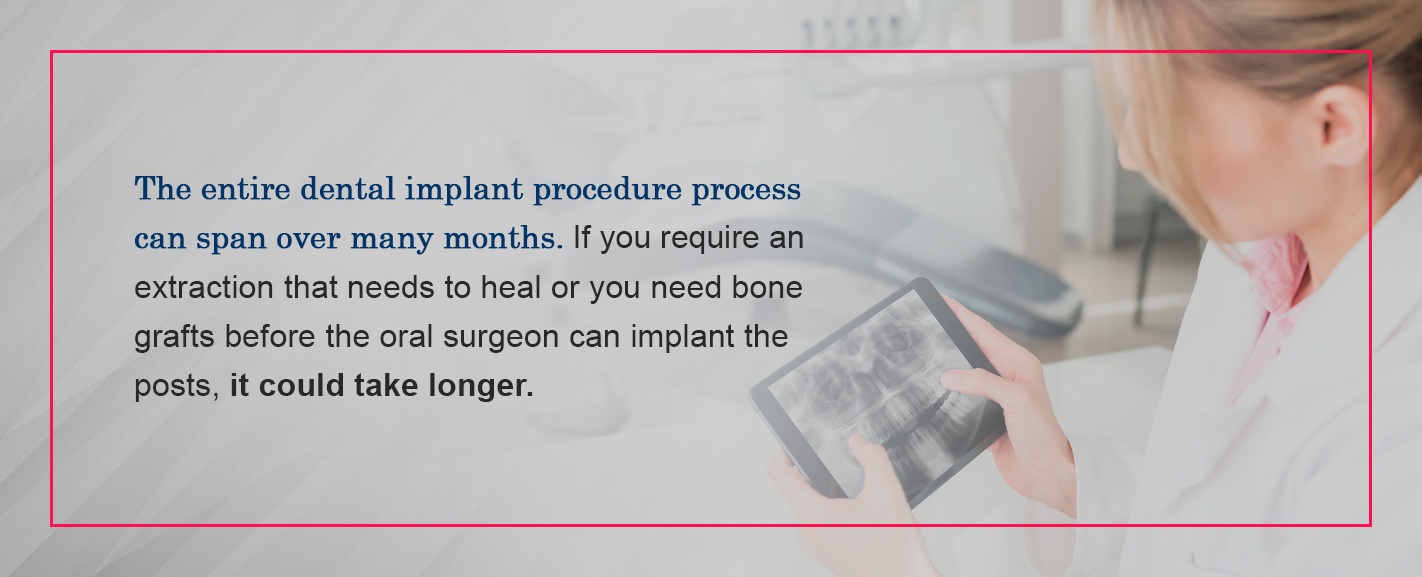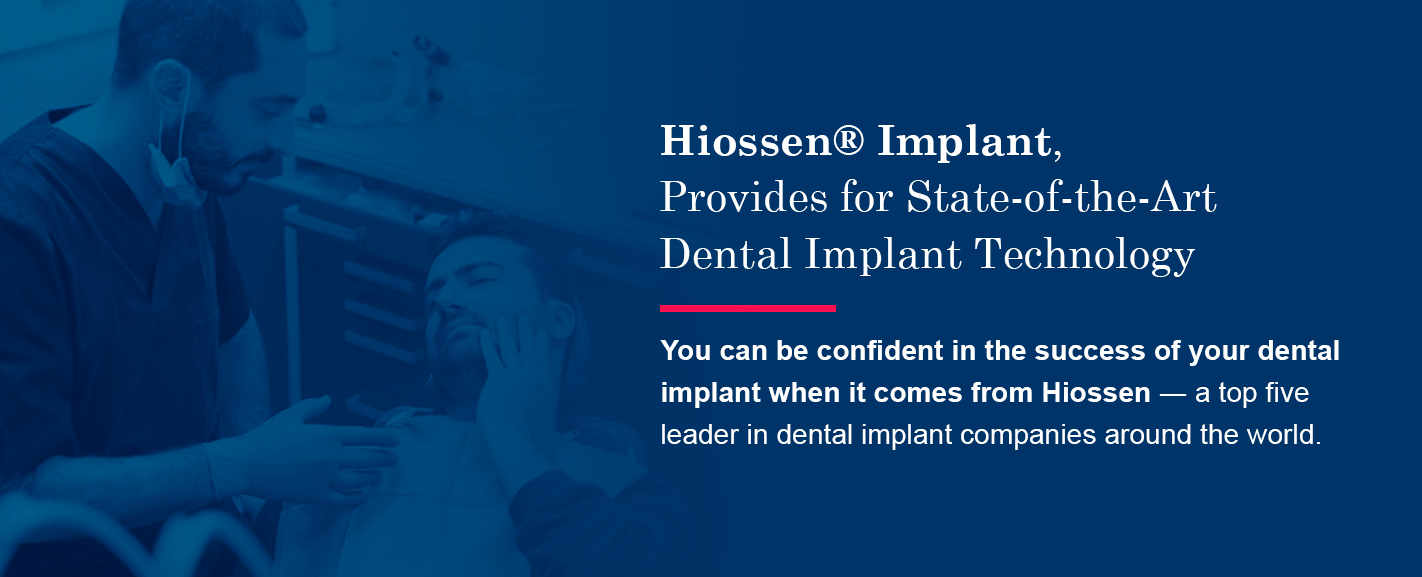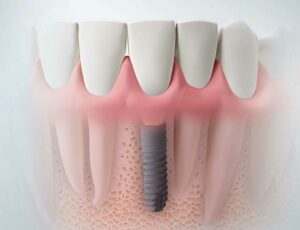Three million individuals in the U.S. have dental implants — and the number increases by 500,000 yearly. In the past 40 years, implant development and use became a considerable advancement in dentistry. If you have missing teeth or need to replace one or more teeth, dental implants are an excellent long-term option to restore your smile.
What Are Dental Implants?
Dental implants are an effective and popular way to replace missing teeth. They are artificial teeth roots dentists place into your jaw to hold a bridge or replacement tooth. They’re made to blend in naturally with your other teeth. They could be an option for you if you lost a tooth or teeth as a result of an injury, periodontal disease or another reason.
What Are the Benefits of Dental Implants?
The many benefits of dental implants include:
- They don’t shift or slip, providing you the same security and stability as your natural teeth.
- They don’t need to soak overnight. You clean them how you would your natural teeth.
- They don’t rely on surrounding teeth for support so you don’t lose any tooth structure like you would for fabricating a bridge.
- They keep your other nearby teeth from shifting which preserves your jawbone and facial contour.
- They’re an excellent cosmetic solution if you have missing teeth, allowing you to speak and chew with ease.
- They have a general success rate of up to 98%, depending on where the oral surgeon places the implants in your jaw.
- They could last a lifetime with proper care.
Types of Dental Implants

There are two main types of dental implants:
- Endosteal (in the bone): Dentists use this kind of implant most commonly. The various types include cylinders, screws or blades the dentist surgically places into your jawbone. Each implant helps to hold one or more artificial teeth. The oral surgeon will typically place this type of implant if you have removable dentures or a bridge.
- Subperiosteal (on the bone): The oral surgeon places these on top of your jaw using metal framework’s posts that protrude through your gum for holding the artificial tooth/teeth. The oral surgeon will place this type of implant if you have minimal bone height or can’t wear conventional dentures.
Are Dental Implants Safe?
Dental implants are a well-established and safe treatment option for replacing teeth. Manufactures usually craft them from titanium — a type of metal that’s biocompatible with the human body. Oral surgeons and periodontists that place implants are very established and regarded highly in the dental profession. Dental implants are the only method of tooth restoration that stimulates the natural bone you have under your missing tooth.
While you might have some apprehension or fear of the implant procedure, dental implant surgery is extremely secure and delicate. It’s a very detailed procedure that ensures minimal risk to you and the highest level of comfort.
Are You a Good Candidate for Dental Implants?
Typically, if you’re healthy enough to undergo oral surgery or even a routine dental extraction, you’re an ideal candidate for dental implants. But, you should have enough bone to hold the implants and healthy gums. You must also commit yourself to routine dental visits and good oral hygiene. If you smoke heavily or suffer from an uncontrollable chronic disorder like heart disease or diabetes or if you had radiation therapy to your neck/head area, the dentist will need to evaluate you to determine if dental implants are an option for you.
What to Know For a Dental Implant Procedure?
The dental implant procedure is a team effort between your dentist, your oral surgeon and you. Your dentist and oral surgeon will talk with you to determine how and where they should place your implant. Depending on the type of implant chosen and your specific condition, they’ll create a custom treatment plan tailored to meet your particular needs.
 Here are some dental implant procedure options:
Here are some dental implant procedure options:
- Single tooth replacement: You’ll require only one implant and crown to replace your single missing tooth.
- Several teeth replacement: You’ll require an implant-supported bridge to replace several missing teeth.
- Complete teeth replacement: If all your teeth are missing, you’ll require full dentures or a full implant-supported bridge to replace them.
- Sinus augmentation: The quality and quantity of your bone where the oral surgeon will place your implant is key to implant success. Because the upper back jaw tends to have insufficient bone quality and quantity and is close to the sinus, it’s traditionally a challenging area to place dental implants successfully. Sinus augmentation, or sinus lift, helps correct this issue because it raises the sinus floor and helps develop bone for dental implant placement.
- Ridge modification: Deformities in your lower or upper jaw can result in you not having enough bone for dental implant placement. To correct this issue, the oral surgeon will lift your gum away from the ridge, exposing the bony defect. They’ll then fill the defect with bone or a type of bone substitute to build the ridge up. Ridge modification can improve appearance greatly and increase your likelihood of experiencing successful implants.
Dental Implant Surgery — What to Know Before Your Procedure
During your planning stage and consult with your oral surgeon, they’ll examine the area in your mouth carefully where they’ll place the dental implant.
Here’s what you need to know about planning a dental implant procedure.
1. Your dentist will require X-rays for assessment and prognostic purposes. They may use X-rays, a 3D CT scan or panoramic X-rays to determine gum and bone condition, and for identifying any warnings.
2. Your dentist takes an impression of your mouth to obtain a good replica of your gums, teeth and the neighboring tissues they’ll use. They’ll determine the correct size metal or plastic impression tray for your mouth and then fill the tray with a soft liquid like polyvinyl siloxane or alginate.
They’ll have you bite down on the impression tray and hold it there for a minute or two to allow the liquid to set and become a solid rubber mass. You’ll then open your mouth and the dentist will remove the tray and send it off to a lab for processing.
3. Your dentist and/or oral surgeon will talk with you about the procedure and address any questions or concerns you have.
4. Your dentist will likely give you some pre-operative instructions you’ll need to follow, including things like:
- Rinsing your mouth with chlorhexidine or another type of anti-bacterial mouthwash.
- Prescribing you antibiotics you’ll take for several days before your procedure, as a preventative measure.
- Having you eat a good breakfast the day of your procedure unless you’re having the surgery performed under IV sedation.
- Bringing someone with you to the appointment to drive you home if you undergo IV sedation or take an oral sedative.
What to Expect During a Dental Implant Procedure?
At this point, you probably want to know the procedure for dental implants. So, what are the steps to getting a dental implant?
You may have the surgical phase of the procedure performed with local anesthesia in the dental office or an oral surgeon may perform it while you’re under IV sedation. There are a couple of phases of the procedure.
Phase One
If you still have the tooth in question, the dentist or oral surgeon will need to extract it first. Your oral surgeon can do this the same time they insert the implant.
After your extraction:
1. The oral surgeon will numb your mouth thoroughly with local anesthesia for the surgical implant placement.
2. They’ll make an incision in your gums where they’ll place the implant to expose the underneath bone.
3. They’ll use a quiet, specialized drill to drill a hole and create a space in the bone for the implant.
4. They’ll screw the implant in place using the same implant drill or a hand tool.
5. Once they fit the implant in place, they’ll screw a second component into the implant which will stay in place during your healing process.
6. They’ll close your gums over the implant with one or two stitches.
7. Your implant will become attached to your bone securely over the next several months.
Phase Two
1. The oral surgeon will re-expose your implant. They’ll make another small incision in your gums, exposing your implant unless they placed a separate component on your implant that sits above your gums.
2. They’ll place a small extension on your implant to take an impression. The lab will use this component to fit your new crown.
3. Your dentist will begin setting a series of appointments for making the crown for your implant. While steps may differ for your case, they typically include creating impressions of your teeth. The dentist or oral surgeon will make exact working models from these impressions of your mouth, which they mount carefully for proper alignment. The lab fabricates your crown from these models.
4. The oral surgeon or dentist will place your new crown during the final step of the procedure. Your oral surgeon might want to try your new crown in first before it’s completed to check the fit and shape of it inside your mouth.
How Long Does a Dental Implant Procedure Take?
Now that you know the dental implant procedure steps, you want to understand the factors determining how long your implant procedure will take, including:
- The number of involved teeth
- Your oral health
- If you require a tooth extraction before your implant placement
- Which teeth you’ll have replaced

The entire dental implant procedure process can span over many months. If you require an extraction that needs to heal or you need bone grafts before the oral surgeon can implant the posts, it could take longer.
The number of visits you’ll pay your dentist throughout your treatment period will also depend on these factors. For example, it generally only takes about an hour or two from start to finish to surgically insert one tooth implant. And, this includes anesthesia time and dressing you for a sterile surgical atmosphere.
If you ask yourself, “do they put you to sleep for dental implants,” the answer is yes. It’s possible the oral surgeon will have you sedated for your implant procedure if you request it, or depending on your medical history and the complexity of your case.
How Painful Is a Dental Implant?
Usually, the oral surgeon or dentist performs a dental implant procedure under local anesthetic, so you shouldn’t experience any dental implant procedure pain. Once the local anesthetic wears off, however, you may experience a little post-surgery discomfort. If so, the discomfort you experience will feel similar to the discomfort you’d experience following a tooth extraction.
To help reduce swelling, immediately following your procedure, you can place an ice pack on your skin over the area you had surgery. Usually, you can manage post-surgery pain with over-the-counter medicines like acetaminophen (Tylenol) or ibuprofen (Advil). But, if your surgery was more invasive, you might need a stronger prescription pain medicine. Your dentist might prescribe you an oral rinse and antibiotics to support healing.
How Long Do Dental Implants Take to Heal?
Because a dental implant procedure involves multiple steps, you may experience more than one healing stage. So, the time it takes to heal will vary, depending on your health and the number of teeth you have replaced. And again, it can take between six to nine months to fully restore your mouth or longer if you require bone grafts or extractions.
There is a chance of your dental implant failing and not adhering to the bone. In this case, you may wonder, “can a failed dental implant be replaced?” Usually, you can choose to have a failed implant replaced with another implant.
There could be dental implant problems years later. Your dental implant procedure could be an immediate success but develop complications years later. Some dental implant complications you could experience include:
- Tissue or nerve damage could occur if the oral surgeon placed your implant too close to a nerve. In this case, you’ll want to look out for tingling or numbness in your lips, tongue, face or gums as signs of this.
- While foreign body rejection usually doesn’t occur that often, it can still occur. This is where your body rejects the implant. If the implant area swells or you experience increased pain, chills and fever, these could signal your body rejecting your implant.
- If the oral surgeon placed your implant in your upper jaw, it could protrude into your sinus cavity.
- If an injury occurs to the site surrounding your dental implant, it could loosen your implant.
To reduce the likelihood of long-term complications, continue practicing good oral hygiene to keep your implants, mouth, teeth and gums healthy. Along with good oral hygiene habits, if you want your implants to last, you’ll also want to set routine dental visits for professional cleanings and exams.
Hiossen® Implant, Provides for State-of-the-Art Dental Implant Technology
It’s a big step making the decision to have a dental implant procedure. You’ll want to sit down with your dentist and/or oral surgeon to go over the procedure entirely, so you know what to expect during a dental implant procedure and come prepared for all the steps involved. You can be confident in the success of your dental implant when it comes from Hiossen ― a top five leader in dental implant companies around the world. Hiossen Implant is dedicated to offering innovative, safe, high-quality and effective dental implants.




